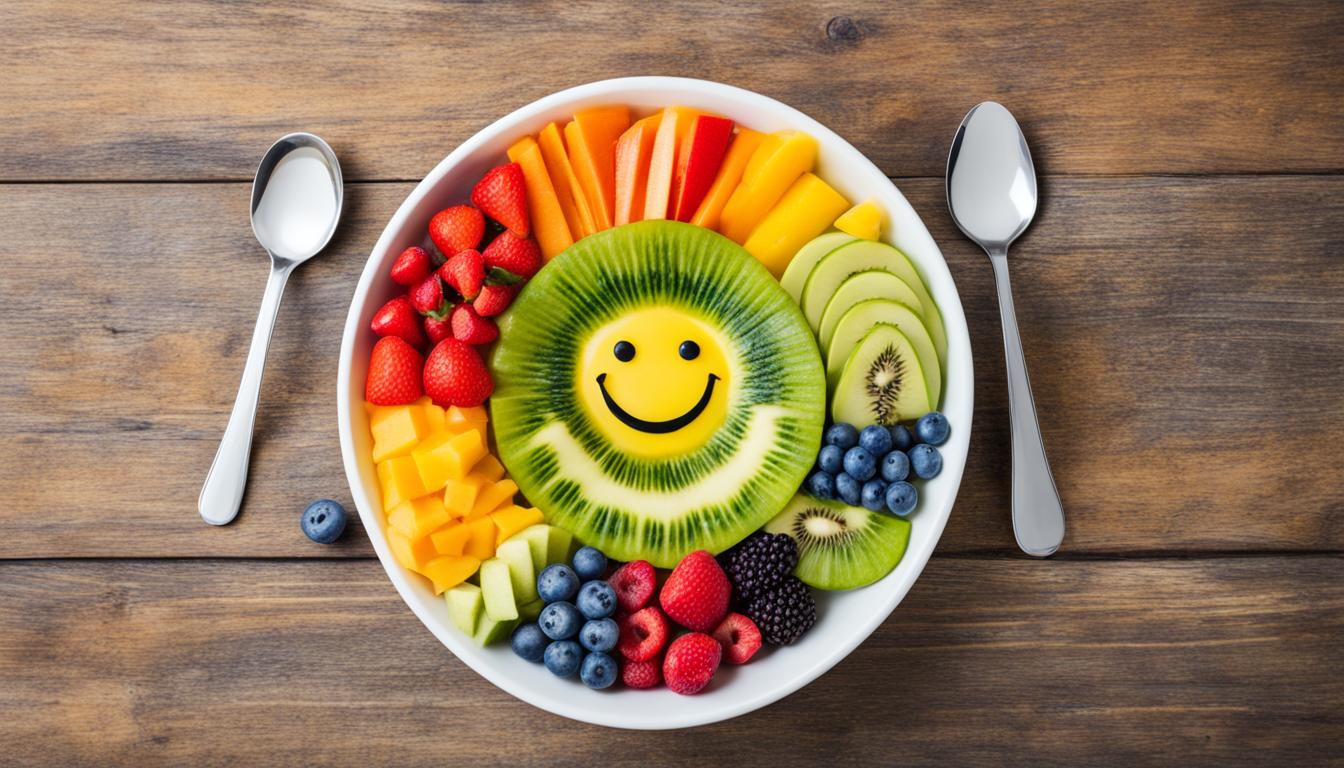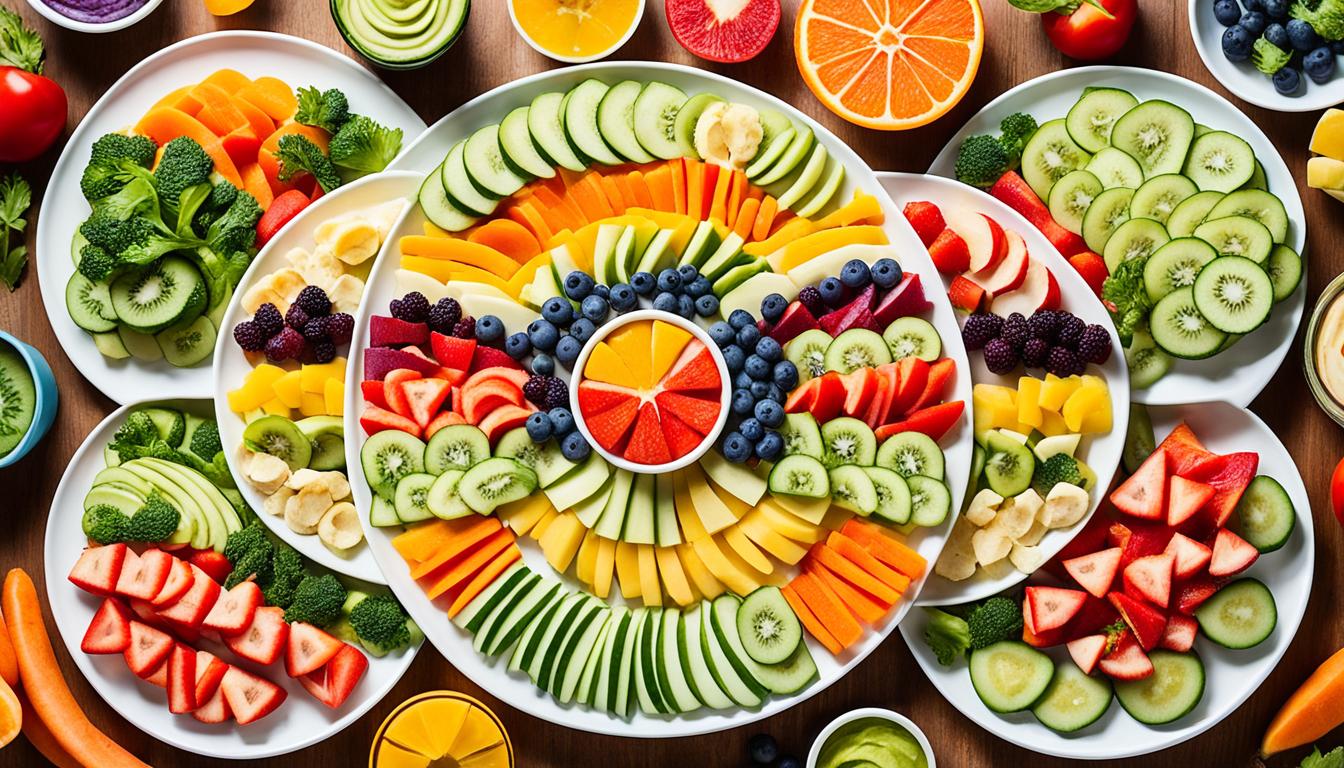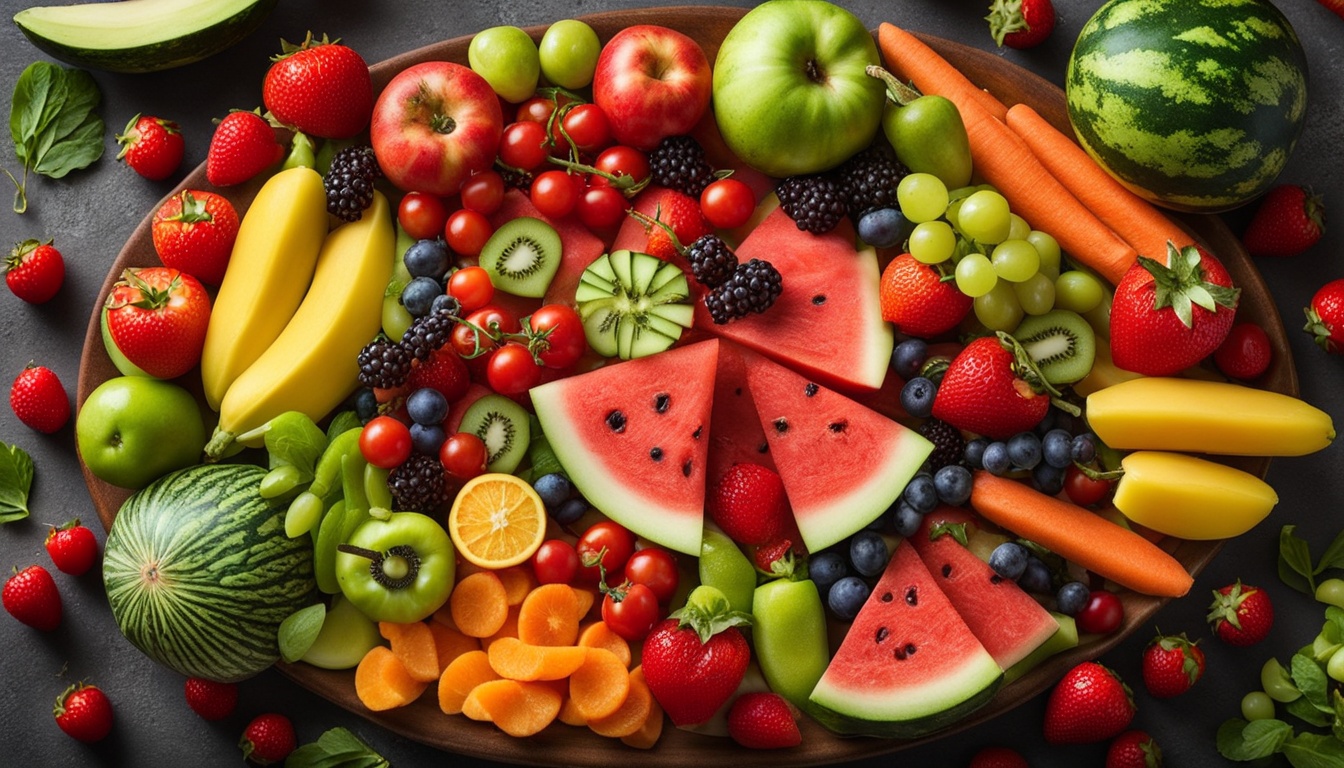As a parent, you are the cornerstone of your child’s dietary habits, influencing their health now and in the future. This guide delves into the importance of healthy eating for kids, offering practical advice to encourage nutritious habits. Discover how proper nutrition is crucial for your child’s growth and development, impacting their physical and emotional well-being. Given the challenges of busy lifestyles, we focus on simple strategies for meal planning that’s both nutritious and manageable. Let’s embark on a path to instill a lifelong love for healthy eating in your children, paving the way for their overall wellness.
Key Takeaways
- Limit juice intake to 4-6 ounces per day for preschoolers.
- Water and milk are the best beverage choices for kids.
- Parents should model healthy eating to promote good habits.
- Simple food swaps can lead to healthier choices over time.
- Family meals create comfort and establish healthy dining routines.
- Encouraging active play can help reduce unhealthy snack habits.
Importance of Healthy Eating for Children
Healthy eating is vital for your child’s growth and overall health. Starting with nutritious habits early sets the stage for a lifetime of benefits. By prioritizing kids nutrition, you lower the risk of future health issues like obesity and chronic diseases.
Benefits of Nutritious Meals
Nutritious meals offer numerous advantages for kids. They help maintain energy levels, improve mood, and support brain health. Balanced diets also reduce the intake of harmful foods, lowering the risk of mental health problems. Studies indicate that kids eating well perform better academically and emotionally.
The Australian dietary guidelines suggest a varied diet with specific servings for each age group. This approach ensures your child gets the essential vitamins and minerals for growth. A diverse diet is key to meeting nutritional needs and supporting overall health.
Long-Term Health Implications
Childhood dietary choices shape long-term health. A balanced diet can prevent chronic diseases, such as heart disease, which often results from early unhealthy eating habits. Kids who understand healthy eating are more likely to stick with it as adults.
Focus on kids nutrition by including fruits, vegetables, whole grains, and lean proteins. This approach can lead to healthier habits later in life. A strong nutritional base helps children make better food choices, positively affecting their long-term health.

Healthy Eating for Kids: Basic Guidelines
Setting a strong foundation for healthy eating in childhood is vital for long-term health. It’s key to focus on the recommended food groups. These include fruits, vegetables, whole grains, protein foods, and dairy, each offering unique benefits for kids’ growth and development.

Recommended Food Groups
Ensuring a mix of the recommended food groups helps kids get the nutrients they need. Aim for at least five servings of fruits and vegetables daily. These foods are packed with vitamins and minerals and help with hydration. Whole grains are crucial for fiber and a healthy digestive system.
Protein sources like lean meats, fish, beans, and nuts are essential for growth and repair in active kids. Dairy products, especially low-fat options, provide calcium for strong bones and teeth.
Defining Balanced Meals
Balanced meals for kids should include portions from various food groups for nutrient diversity. A typical meal might have a protein source, whole grains, and a couple of servings of colorful vegetables. It’s important to limit fried foods and choose healthier cooking methods.
Opting for water or low-fat milk over sugary drinks can improve dietary quality. Establishing regular meal and snack times helps kids understand their hunger cues. Spending time on family meals can also encourage healthier eating habits and reduce unhealthy snacking.
For more detailed insights on meal planning, check out this balanced diet guide.
Getting Started with Meal Planning
Busy parents often find meal planning to be a valuable tool for simplifying their week. It transforms mealtime chaos into a more organized experience. By setting aside a specific time each week for meal planning, you can foster healthy eating habits in your family.
Effective Strategies for Busy Parents
Start by dedicating 20-30 minutes weekly to plan meals. This small time investment can significantly reduce stress during the busy week ahead. Choose a day that fits your family’s schedule. During this time, outline meals that include various food groups like protein, fruits, vegetables, grains, and dairy.
This ensures you meet dietary guidelines and make nutritious choices. Engaging your children in meal planning is a fun way to teach them about healthy eating. Let them help with selecting recipes and making a shopping list. This approach empowers them and encourages a sense of responsibility towards their food.
Adding themes like “Meatless Mondays” or “Taco Tuesdays” can make meal planning for kids exciting and varied.
Making a Weekly Menu
Your weekly menu should include staples and new recipes to keep meals interesting. For example, a typical day might feature whole grain toast for breakfast, colorful vegetable snacks, and a wholesome dinner with beans and fresh veggies. Consider your children’s caloric needs based on their age and activity levels.
This ensures you meet their nutritional needs while staying within a budget. Using meal planning services like Prep Dish can streamline the process. These tools provide pre-designed meal plans and grocery lists, helping families maintain healthy eating habits despite a busy schedule.
By committing to consistent meal planning and integrating these strategies, you can create a healthier, happier family dining experience.
Involving Kids in the Kitchen
Engaging children in the kitchen turns meal preparation into an exciting, educational journey. By including your kids in cooking, you teach them valuable skills and foster a deeper appreciation for food. This involvement can significantly boost their interest in nutrition, encouraging them to try a variety of foods.
Fun Activities for Children
Begin by letting kids pick out fruits and vegetables at the grocery store. This activity makes them feel connected to the meals you create. As they assist with meal prep, they’ll gain insights into cooking techniques and ingredients. Tasks like measuring ingredients can also enhance their math skills, such as counting and fractions.
Encouraging Experimentation with Food
Encourage your children to be creative with their meals. Let them experiment with flavors and textures, perhaps by making their own side dishes using child-friendly recipes. This creative freedom helps develop their culinary skills and makes them more open to trying new foods. Kids who cook often eat an extra serving of veggies, leading to better nutrition.
Child-Friendly Recipes for Healthy Eating
Feeding your kids nutritious meals can be both simple and rewarding. Discover a range of recipes tailored for their tastes and dietary needs. These include easy breakfast ideas, lunch options, and snack ideas that are both fun and healthy.
Simple Breakfast Ideas
Begin the day with breakfast ideas that are both simple and appealing to kids. Consider making egg sandwiches on whole-grain bread with fresh veggies for extra nutrition. Greek yogurt parfaits with fruits and granola offer a mix of protein and sweetness. These options make healthy eating a positive experience, helping kids start their day energized.
Easy Lunch Options for Kids
At lunchtime, opt for easy lunch options that are both colorful and enjoyable. Whole-grain wraps filled with lean meats, cheese, and various veggies can be tailored to your child’s tastes. Salads with beans, corn, and cherry tomatoes provide a nutritious and vibrant meal. Adding sweet potatoes and chickpeas boosts the fiber content, ensuring the meals are both tasty and healthy.
Snack Ideas That Kids Will Love
Snacks are crucial for sustaining energy levels, so it’s important to have a variety of snack ideas at hand. Healthy choices like veggie sticks with hummus or yogurt-dipped fruit combine fun with nutrition. Using ingredients like veggie dogs or baked popcorn shrimp offers healthier alternatives to traditional snacks. By being creative and varied with these recipes, you can make mealtime an exciting experience for your kids.

Creating a Positive Eating Environment
Creating a positive eating environment is crucial for fostering healthy eating habits in children. It shapes their relationship with food and mealtime experiences. Family meals are key in ensuring kids eat nutritious foods like fruits, vegetables, and whole grains. These meals not only support healthier eating but also strengthen family bonds.
Family Meals and Their Benefits
Studies indicate that family meals bring numerous advantages. Kids who eat with family members tend to have a richer vocabulary and better social skills. These meals can also lower the risk of substance abuse in teens, underscoring their importance. Aim for a setting where everyone feels at ease sharing their thoughts, which positively impacts children’s eating habits.
Reducing Distractions During Meals
Reducing distractions during meals is vital for a positive eating atmosphere. Limit screen time and disconnect from devices to enhance conversation and enjoyment. When kids are fully present and attentive, they better understand their hunger and fullness signals. Offering meals or snacks every 2 to 3 hours aids in maintaining healthy eating habits. Mindful eating fosters better digestion and a deeper connection to food.
Addressing Picky Eaters: Solutions and Tips
Picky eating is a common issue for parents, often causing stress during meal times. Recognizing this behavior as a normal part of child development can ease concerns. Adopting various strategies can foster a positive atmosphere that encourages kids to try new foods.
Encouraging Tasting New Foods
Making food exploration enjoyable is a key picky eaters solution. Consider turning meals into fun challenges, where tasting new foods becomes a game. It often requires multiple attempts for children to accept a new food.
Offering a variety of healthy options, especially fruits and vegetables, allows kids to experiment safely. Involving them in grocery shopping can boost their excitement about meals. When children feel they have a say in their food choices, they’re more likely to be open to new foods.
Strategies to Reduce Meal Time Stress
A stress-free environment is crucial during meals. Avoid forcing children to eat or clean their plates, as this can create negative associations with food. Instead, try to normalize the presence of a disliked food item on their plate, assuring them it doesn’t have to ruin the meal.
Providing a backup meal option can ease tension if kids refuse the primary dish. This approach helps avoid food fights while ensuring proper nutrition. Consult health experts for guidance on maintaining a balanced diet without the battles over specific items.
Healthy Snacks for Kids
Finding healthy snacks for kids can be both fun and beneficial for their growth. These snacks provide the energy and nutrients children need throughout the day. They help keep them focused and alert. Incorporating a variety of snacks into your child’s routine ensures they receive essential nutrients while enjoying tasty treats.
Nutritious Snack Options
Excellent choices for healthy snacks include yogurt, which offers protein and calcium vital for developing bones. Opt for yogurts with live bacteria to support digestion. Nuts and trail mix, made with nuts and dried fruits, provide healthy fats, fiber, and antioxidants. These snacks are perfect for children on the go.
Whole-grain crackers paired with cheese or fresh fruit create nutritious snack options that are easy to prepare. Eggs are another nutritious choice, rich in protein, vitamins, and minerals. For a sweet treat, try raisins, which contain iron important for oxygen transport in the body. Avocado, full of heart-healthy fats and vitamins, is also a great option.
Making Snacks Fun and Appealing
Making healthy snacks fun increases the likelihood that your kids will enjoy them. Use creative plating techniques to make fruits and veggies appealing. Encourage your children to build their snacks, such as creating their own trail mix with nuts, dried fruit, and popcorn. Another engaging idea includes colorful smoothie bowls made from yogurt blended with fruit juice and frozen peaches, topped with berries or granola.
Remember to serve snacks in controlled portions, as snacks should not replace meals. Utilizing snack-size bags can help kids understand portion sizes, reinforcing healthy eating habits. For more ideas on promoting nutritious eating for your kids, explore pediatric health tips.

Promoting Good Eating Habits Early On
Creating a supportive environment for healthy eating starts with adults in a child’s life. As a parent or guardian, your nutrition approach significantly impacts your child’s eating habits. By modeling healthy eating, you show the value of balanced meals and nutritious snacks. Getting your children involved in meal planning and cooking teaches them about food selection and preparation, enhancing their sense of responsibility over their diet.
Role Modeling Healthy Choices
Your eating habits set a strong example for your children. Seeing you choose fruits, vegetables, and whole grains encourages them to do the same. Make trying new foods a family event, showing that it might take several attempts to like something new. Studies indicate that kids often need to try a new food at least three times before they decide if they like it. Praise their efforts, even if they don’t like the food, to keep a positive view of trying new things.
Establishing Routines Around Meals
Setting regular meal times adds stability and predictability to your child’s day. Consistent family meals are great for bonding and help prevent overeating or constant snacking. Prioritizing water and minimizing distractions during meals teaches your children healthier eating habits. Turning grocery shopping into a learning experience by reading nutrition labels helps them understand healthy choices. These routines lay the groundwork for a lifetime of healthy eating.
Conclusion
Healthy eating is essential for kids’ development and well-being. As a parent, you are crucial in guiding your child’s dietary habits. Encouraging them to eat five portions of fruits and vegetables daily is key. Ensuring they get enough calcium, about 350mg for kids aged one to three, aids in their growth and development.
Creating a positive eating environment at home is crucial. Engage in meal planning and introduce child-friendly recipes. Letting children help with cooking makes healthy eating fun. It’s also important to balance salt and sugar intake, as kids often consume too much from processed foods. Teaching them about healthy options empowers them to make better choices.
The habits you establish now will benefit your child’s physical, emotional, and mental health. Schools and communities are emphasizing nutrition education, and your efforts at home will support these efforts. Your dedication to healthy eating for kids is a lasting investment in their health.
FAQ
Why is healthy eating important for children?
How can I encourage my picky eater to try new foods?
What are some easy child-friendly recipes I can prepare?
How can I set up a positive eating environment at home?
What are the recommended food groups for kids?
How can I effectively plan meals for my busy family?
What nutritious snacks can I provide for my kids?
How can I model healthy eating habits for my children?
Source Links
- Kids and Food: 10 Tips for Parents (for Parents) – https://kidshealth.org/en/parents/eating-tips.html
- Nutrition Tips for Kids – familydoctor.org – https://familydoctor.org/nutrition-tips-for-kids/
- Healthy eating for children – https://www.healthdirect.gov.au/healthy-eating-for-children
- Healthy Food for Kids – HelpGuide.org – https://www.helpguide.org/articles/healthy-eating/healthy-food-for-kids.htm
- Importance of Good Nutrition for Kids | Children’s Bureau – https://www.all4kids.org/news/blog/importance-of-good-nutrition-for-young-children/
- What nutrients does your child need now? – https://www.mayoclinic.org/healthy-lifestyle/childrens-health/in-depth/nutrition-for-kids/art-20049335
- Healthy Eating (for Parents) – https://kidshealth.org/en/parents/habits.html
- Healthy Meal Plans for Kids – https://www.healthline.com/health/food-nutrition/healthy-meal-plans-for-kids
- Simplify Healthy Eating With Meal Planning – https://kidscookrealfood.com/meal-planning-for-healthy-eating/
- Building a healthy meal plan for your family — Nutrition For Kids – https://www.nutritionforkids.com.au/blog/healthy-meal-planning
- The Benefits of Including Kids in the Kitchen – https://extension.usu.edu/healthwellness/research/benefits-of-including-kids-in-the-kitchen
- Kids in the Kitchen | Nutrition.gov – https://www.nutrition.gov/topics/nutrition-life-stage/children/kids-kitchen
- Healthy kids’ recipes – https://www.bbcgoodfood.com/recipes/collection/healthy-kids-recipes
- A Month of Healthy Dinner Ideas for Kids – https://www.eatingwell.com/gallery/13903/a-month-of-healthy-dinner-ideas-for-kids/
- Parents’ Influence on Children’s Eating Habits – https://www.unlockfood.ca/en/Articles/Adolescents-teenagers/Parent-and-Caregivers-Influence-on-Children’s-Eating-Habits.aspx
- PDF – https://www.anfponline.org/docs/default-source/legacy-docs/docs/ce-articles/mc112021-02.pdf
- Creating a Positive Food Environment in Schools | EOHU | Public Health – https://eohu.ca/en/my-community/creating-a-positive-food-environment-in-schools
- How to Help Kids Who Are Picky Eaters – Child Mind Institute – https://childmind.org/article/how-to-help-kids-who-are-picky-eaters/
- 10 Tips for Parents of Picky Eaters – https://www.healthychildren.org/English/ages-stages/toddler/nutrition/Pages/Picky-Eaters.aspx
- 28 Healthy Snacks Your Kids Will Love – https://www.healthline.com/nutrition/healthy-snacks-for-kids
- Snack Attack: Healthy Snacking for Kids – https://www.childrenscolorado.org/conditions-and-advice/parenting/parenting-articles/healthy-snacking-for-kids/
- How to Teach Kids Healthy Eating Habits – https://health.clevelandclinic.org/healthy-eating-for-kids
- How to Encourage Your Children to Have Healthy Eating Habits – Stanford Medicine Children’s Health Blog – https://healthier.stanfordchildrens.org/en/how-to-encourage-your-children-to-have-healthy-eating-habits/
- Caring for Kids: 5 Tips for Developing Children’s Healthy Eating Habits – https://hr.umich.edu/about-uhr/uhr-news/caring-kids-5-tips-developing-childrens-healthy-eating-habits
- Healthy eating for children – https://www.nidirect.gov.uk/articles/healthy-eating-children
- III. CONCLUSIONS AND RECOMMENDATIONS – https://www.fao.org/4/ai004e/AI004E04.htm
- Nutrition for Kids – Why Is It Important & Necessary – https://www.hdfcergo.com/health-insurance/wellness-corner/child-wellness/nutrition-for-kids


